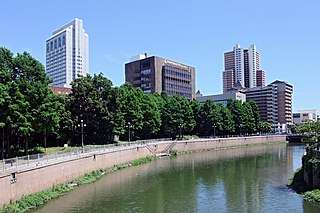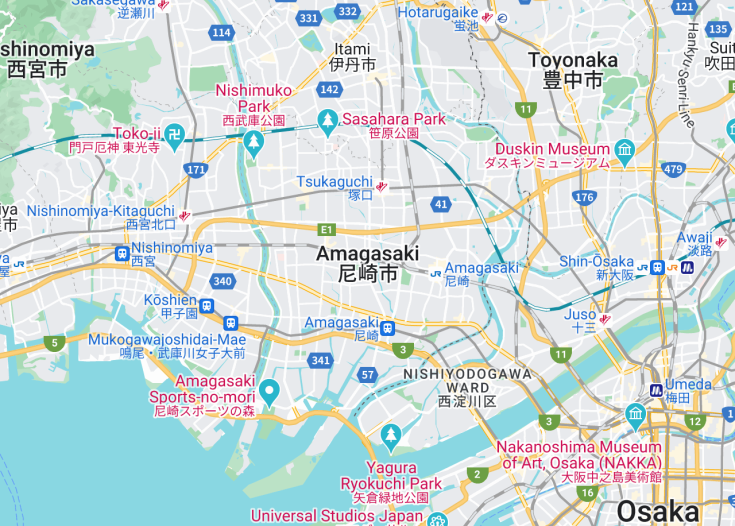Amagasaki, a city uniquely bridging the historical and the modern, is nestled in Hyogo Prefecture, Japan. Known for its rich cultural tapestry and industrial backbone, Amagasaki offers a remarkable blend of scenic beauty with its riverbanks and traditional landscapes juxtaposed against thriving industries. The city is renowned for its contributions to Japan’s sake brewing industry, making it a must-visit for enthusiasts of traditional Japanese beverages. With its convenient proximity to Osaka and Kobe, Amagasaki serves as a perfect starting point for exploring the wider Kansai region.
Before visiting Amagasaki, explore its historical sites online to better appreciate its cultural and industrial significance during your stay.
To fully experience the local culture, consider timing your visit with one of Amagasaki’s vibrant seasonal festivals, which showcase the city’s lively community spirit and traditions.
Top things to do & see in Amagasaki
Select the following sights and activities to discover best tickets and tours available in Amagasaki.
Amagasaki: A Dynamic Blend of Tradition and Modernity
| Country | Japan |
| Time in Amagasaki | GMT+9 |
| Language spoken | Japanese |
| Population | 460,000 (source: Latest Urban Area Data) |
| Currency | Japanese Yen (¥, JPY) |
| Airports |
|
Amagasaki, a city nestled in the Hyogo Prefecture of Japan, stands as a vibrant hub where the rush of modernity intersects with rich cultural heritage. Positioned between the famous cities of Osaka and Kobe, Amagasaki acts as a crucial transitional zone, offering insights into the urban and social dynamics of the region.
Historically, Amagasaki was known for its robust agricultural base, which gave way to heavy industrialization post-World War II. Today, the city flaunts a well-diversified economy, with notable advancements in technology, manufacturing, and service industries. Cultural expressions are deeply ingrained in the city’s ethos, highlighted by its annual festivals and vibrant artistic scenes that attract visitors from across Japan. The city also serves as a significant logistical and transportation gateway due to its strategic location and accessibility.
The urban landscape of Amagasaki is a blend of contemporary buildings, traditional wooden houses, and well-preserved historical sites that offer a chronological journey through Japan’s architectural evolution. Public parks and riverfront areas provide residents and visitors alike with peaceful retreats from the urban sprawl.
Education and innovation find a special place in Amagasaki’s developmental agenda, with numerous educational institutions paving the way for research and development initiatives that contribute to both local and national advancements. The city’s proactive approach to sustainability and urban development serves as a model for neighboring cities aiming for modernization while preserving cultural identity.
Where is Amagasaki?
Amagasaki lies in the southern part of Hyogo Prefecture, flanked by the cities of Osaka and Kobe, forming part of the Osaka-Kobe-Kyoto Metropolitan area.
Distances:
| Route | Distance by car | Time by car |
|---|---|---|
| Osaka to Amagasaki | 10 miles | 20 minutes |
| Kobe to Amagasaki | 12 miles | 25 minutes |
| Kyoto to Amagasaki | 35 miles | 50 minutes |
What is Amagasaki famous for?
Amagasaki is renowned for its robust industrial sector and cultural festivals. The city uniquely blends its post-war economic success with traditional festivities that draw cultural enthusiasts.
History
Prehistoric to Feudal Japan (Before 1615)
Amagasaki, located in the Hyogo Prefecture of Japan, has a rich history that traces back to prehistoric times. Initial settlements were primarily fishing and agricultural communities, benefiting from the fertile lands and proximity to the sea. The region saw significant development during the feudal era, becoming a crucial point for trade and military strategy. This period shaped much of the early cultural and social structures of Amagasaki, laying the groundwork for its future growth.
Edo Period (1615-1868)
During the Edo period, Amagasaki flourished under the Tokugawa shogunate’s policies, which stabilized Japan and promoted economic growth. The town’s strategic location along important trade routes helped it develop into a bustling center for commerce. Traditional crafts and industries, especially sake brewing, began to thrive during this time, establishing Amagasaki as a key economic hub in the region.
Meiji Restoration to World War II (1868-1945)
The Meiji Restoration marked a significant shift as Japan embraced rapid modernization. Amagasaki industrialized quickly, with its geography playing a pivotal role in its development as an industrial center. The town’s factories contributed to Japan’s burgeoning industrial output, which saw further expansion during the early 20th century. However, World War II brought immense challenges, including air raids that caused widespread damage to both the industrial sector and civilian areas.
Post-war Period to Present Day (1945-Present)
In the aftermath of World War II, Amagasaki faced the daunting task of rebuilding. Through resilient efforts, the city not only recovered but also modernized, transitioning to a more diversified economy, including technology and services. Today, Amagasaki is known for its cultural heritage, educational institutions, and as a residential and commercial area that contributes to the broader Kansai region’s economy. Its history of overcoming adversity is a testament to the city’s enduring spirit and continual growth.
Visit Amagasaki
What to see and do in Amagasaki, Japan.
Amagasaki offers a blend of historical sites and modern attractions. Notable sites include:
- Amagasaki Castle – Explore the reconstructed castle and learn about its historical significance in Japanese feudal history.
- Tachibana Park – Ideal for relaxation and experiencing the natural beauty of Amagasaki.
- The Hyogo Prefectural Museum of Art – Offers an impressive collection of contemporary and modern art.
- Amagasaki Cultural Center – Hosts various cultural performances and exhibitions that showcase local talent.
In addition to exploring these sites, visitors can enjoy local cuisine, particularly the region’s famous sake, in various traditional breweries around the city.
Festivals and Events in Amagasaki
Amagasaki is known for its vibrant festivals and events that highlight its rich culture and history. Key events include:
- The Amagasaki Kono Festival – A summer event that features traditional dance performances and parades.
- Amagasaki Castle Illumination – An annual winter event where the castle and surrounding park are beautifully lit up, creating a magical atmosphere.
These events typically take place during the summer and winter seasons, respectively, offering unique experiences that reflect the city’s festive spirit.
Best time to visit Amagasaki
The best time to visit Amagasaki is in the spring (March to May) and fall (September to November). During these months, the weather is pleasantly mild, and the natural scenery is at its most beautiful, making it ideal for sightseeing and outdoor activities. Additionally, these seasons afford visitors the opportunity to partake in the city’s seasonal festivals and events.
Is Amagasaki worth visiting?
Amagasaki, with its rich history, cultural heritage, and variety of attractions, offers a comprehensive travel experience. The city’s historical sites like Amagasaki Castle provide a glimpse into Japan’s feudal past, while modern attractions such as the Hyogo Prefectural Museum of Art offer insights into contemporary culture. However, visitors should be aware that Amagasaki is an urban area, where navigating crowded spaces might be challenging during peak tourist seasons or festivals. Despite this, the city’s unique blend of history, culture, and modernity makes it a worthwhile destination for those eager to explore more than just the typical tourist spots in Japan.










